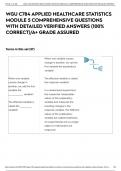Exam (elaborations)
WGU C784 APPLIED HEALTHCARE STATISTICS/WGU 784 OA 2023 ACTUAL EXAM 100 QUESTIONS WITH DETAILED VERIFIED ANSWERS (100% CORRECT)/A+ GRADE ASSURED
- Course
- Institution
WGU C784 APPLIED HEALTHCARE STATISTICS/WGU 784 OA 2023 ACTUAL EXAM 100 QUESTIONS WITH DETAILED VERIFIED ANSWERS (100% CORRECT)/A+ GRADE ASSURED
[Show more]



